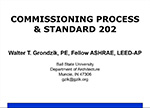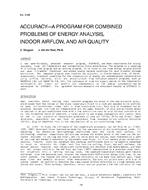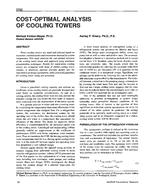Click here to purchase
Some applications may not be included within ASHREA 62.1 database or require a different criteria of fresh air requirements. The aim is to establish reference curves that can relate the space function, represented with the peoples’ density and corresponding metabolic activity and fresh air requirements, to the resultant CO2 concentration inside these spaces. The paper provides a model of a general methodology to assess the fresh ai requirements for any type of a project based on the targeted CO2 levels. The paper methodology is based on combining methodologies of fresh air requirements determination outlined in ASHRAE 62.1 and other mathematical models for pollutants transport equations in the literature. The model is validated via comparative techniques to simulation-based studies, using Integrated Environmental Solution (IES-VE) simulation software. Spaces CO2 concentration simulations output, for several cases with different space function and fresh air supply parameters, are plotted to construct the reference curves using data fitting techniques. Accordingly, these curves can be interpolated and extrapolated to construct a full range references curves that can be used by designers for covering a vast range of cases possibilities. A case study in a project of Saudi Arabia is used to report how these reference curves can be implemented. The study is based on a religious facility project, where it has been requested to have a 15 l/s per person as fresh air design criteria.Using the developed references curves, designers evaluated that the ASHRAE figures may seem too low for the application that resulted in 2,653 a CO2 ppm. The curves show that 15 l/s design criteria result in 800 ppm with only 400 PPM above the air CO2 concentration of 400 ppm. Subsequently, limiting the CO2 to 1200 ppm is deemed an acceptable target for the religious facility application. Using the references curves, 8 l/s per person achieves the targeted 1200 ppm and is adopted accordingly. These curves could be used as a complementary fresh air assessment methodology to the indoor air quality standards, as the designer can have more flexibility in evaluating any application for fresh air requirements.
Citation: 4th Intl Conf: Efficient Bldg Design
Product Details
- Published:
- 2020
- Number of Pages:
- 9
- Units of Measure:
- Dual
- File Size:
- 1 file , 800 KB
- Product Code(s):
- D-ICEB20-16


